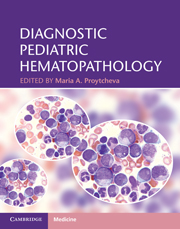Book contents
- Frontmatter
- Contents
- List of contributors
- Acknowledgements
- Introduction
- Section 1 General and non-neoplastic hematopathology
- 1 Hematologic values in the healthy fetus, neonate, and child
- 2 Normal bone marrow
- 3 Disorders of erythrocyte production
- 4 Disorders of hemoglobin synthesis
- 5 Hemolytic anemias
- 6 Inherited and acquired bone marrow failure syndromes associated with multiple cytopenias
- 7 Inherited bone marrow failure syndromes and acquired disorders associated with single peripheral blood cytopenia
- 8 Peripheral blood and bone marrow manifestations of metabolic storage diseases
- 9 Reactive lymphadenopathies
- Section 2 Neoplastic hematopathology
- Index
- References
4 - Disorders of hemoglobin synthesis
Thalassemias and structural hemoglobinopathies
from Section 1 - General and non-neoplastic hematopathology
Published online by Cambridge University Press: 03 May 2011
- Frontmatter
- Contents
- List of contributors
- Acknowledgements
- Introduction
- Section 1 General and non-neoplastic hematopathology
- 1 Hematologic values in the healthy fetus, neonate, and child
- 2 Normal bone marrow
- 3 Disorders of erythrocyte production
- 4 Disorders of hemoglobin synthesis
- 5 Hemolytic anemias
- 6 Inherited and acquired bone marrow failure syndromes associated with multiple cytopenias
- 7 Inherited bone marrow failure syndromes and acquired disorders associated with single peripheral blood cytopenia
- 8 Peripheral blood and bone marrow manifestations of metabolic storage diseases
- 9 Reactive lymphadenopathies
- Section 2 Neoplastic hematopathology
- Index
- References
Summary
Normal hemoglobins
Structure and function of hemoglobin
Hemoglobin consists of two alpha-like and two beta-like globin chains which combine to form a tetramer. The globin tetramer is hydrophilic on its surface, making the molecule water soluble. The center is hydrophobic, stabilizing the heme ring and the iron molecule in the ferrous state (Fe2+). Located in the interior of each globin chain is a heme ring with an iron molecule in the center. It is in the heme ring that oxygen binding and release take place. In addition to oxygen transport, hemoglobin also plays a minor role in the transport of carbon dioxide, and as a scavenger of nitric oxide (NO).
As the partial pressure of oxygen is increased, hemoglobin becomes saturated with oxygen. The partial pressure at which 50% of hemoglobin is saturated is called the p50. Normal subjects have a p50 between 23 and 27 mmHg. Binding of an oxygen molecule in one heme changes the tetrameric structure so that additional oxygen molecules are bound with greater ease; this property of hemoglobin is called cooperativity, and is dependent on interactions between the globin chains (“heme–heme interaction”). The oxygen dissociation curve for hemoglobin A is sigmoid shaped because of this cooperativity (Fig. 4.1) [1, 2]. The sigmoid shape reflects how oxygen binding is favored at high oxygen tensions (lungs) and is rapidly released at low oxygen tensions (tissues).
- Type
- Chapter
- Information
- Diagnostic Pediatric Hematopathology , pp. 57 - 74Publisher: Cambridge University PressPrint publication year: 2011
References
- 1
- Cited by



